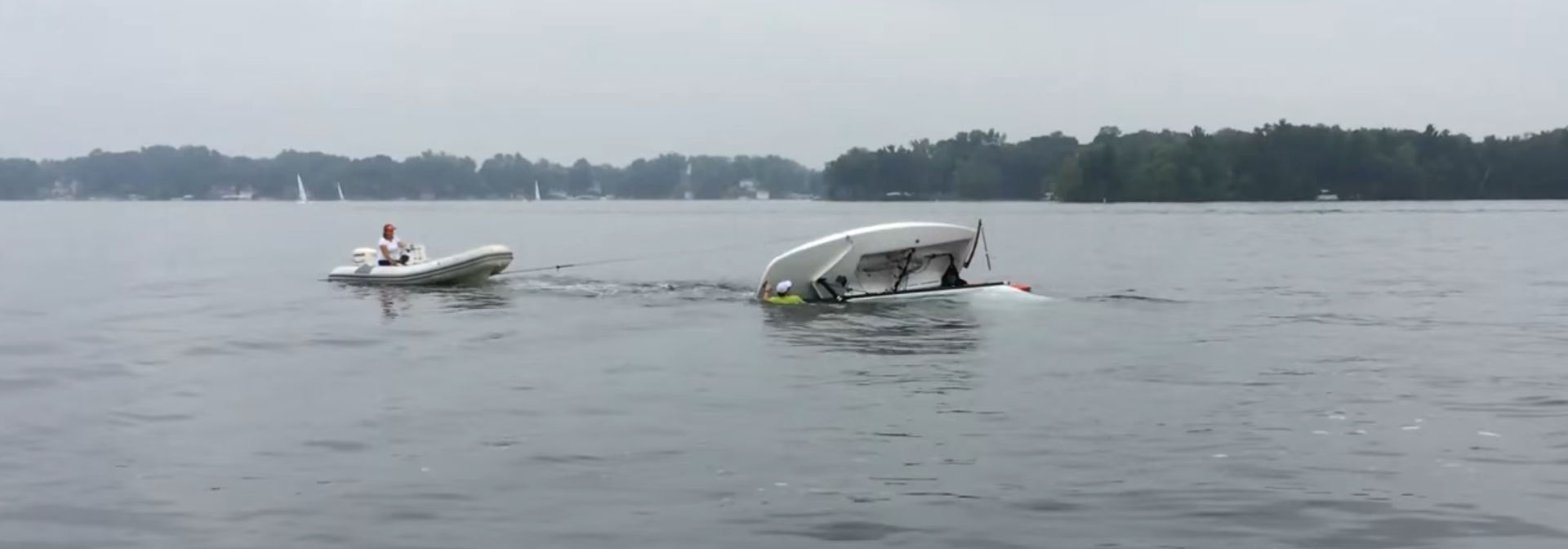Capsize and turtle recovery in a sailboat is easier if you know the tricks. In many small boats, you can quickly recover from a capsize without assistance and keep sailing. If you turtle, or if conditions are less than ideal, you may need help from a chase boat.
We enlisted John Porter to demonstrate capsize and turtle recovery techniques in an MC Scow. He took advantage of a no-wind day to allow for clear audio. We supplemented the audio with on-screen comments.
This post has been updated from the original, with additional tips and links.
Video – Capsize and Turtle Recovery
Key Points
Unassisted capsize recovery
- In heavier dinghies, it’s best to have a permanent righting line to assist.
- After capsizing, throw the righting line over the high side.
- While you’re still near the cockpit, release the mainsheet and the boom vang. This will help prevent the boat from rolling over and capsizing on the other side after you right it.
- If the wind is strong, consider swimming the bow around so it’s head to wind.
- Pull or stand on the centerboard and/or the righting line to right the boat. In a scow, stand on the lower board and use the righting line. The lower board gives more leverage. Standing on the upper board may bend it.
Assisted Capsize Recovery
- Ensure the chase boat driver is experienced and is using a kill cord. Prop guards are highly recommended.
- Chase boat’s first job is to make sure the sailor is OK. If not, get the sailor in the chase boat and worry about the sailboat later.
- Sailor releases mainsheet and vang and stays near the cockpit. Hold on to something in the cockpit to get scooped in when the boat is righted.
- Chase boat approaches the mast tip slowly. Chase boat assistant grabs top of mast and lifts it out of the water.
- Chase boat driver uses slow forward or reverse to turn the bow of the sailboat head to wind.
- Chase boat assistant walks mast up, using hand-over-hand technique.
Assisted Turtle Recovery
- In light boats you can recover from turtling using the same techniques as for capsizing.
- If you need assistance, here are the steps for assisting boat (chase boat):
- Caution: make sure the chase boat driver is experienced and is using a kill cord. Prop guards are highly recommended.
- Chase boat’s first job is to make sure the sailor is OK. If not, get the sailor in the chase boat and worry about the sailboat later.
- Approach the sailboat from the side.
- Rig a long line from the bow of the chase boat to the opposite side of the sailboat. Attach the line to the opposite side shroud chainplate.
- Chase boat backs away from the sailboat at a 30-45 degree angle. Best to have the chase boat back straight into the wind.
- Find the correct angle to back away. You want to avoid just turning the boat.
- The sailor in the water can assist by preventing the bow from turning too much.
- Chase boat uses 30-50% throttle to slowly pull boat up.
- When boat gets on its side:
- Release the vang and mainsheet
- Use more throttle to right the boat
- When boat is upright, may need to remover water by towing with bailers open and transom patches removed.
Related Content
Sailing Capsize Recovery | Scoop & Single-Handed Methods
SailZing Posts on Capsizing



Nice video, might be a step up in safety consideration if the sailor in the water would wear a life vest.
Any videos or instructions for C Scow capsize recovery?